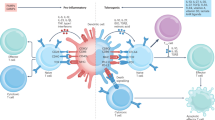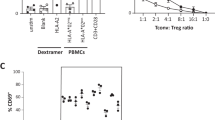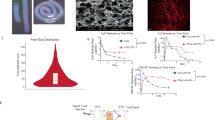Abstract
We studied antigen-specific T-cell tolerization therapy using skin transplantation across a defined minor histocompatibility antigen difference. Specific tolerization protocols using short-lived peptide or long-lived spleen cells presenting the peptide as antigen prevented graft rejection without immunosuppression when started before or as long as 10 days after transplantation. Peptide-induced T-cell tolerance was transient, and antigen presentation by the graft was not sufficient to maintain tolerance. In contrast, transfer of antigen-expressing lymphoid cells induced long-lasting tolerance correlating with donor cell chimerism. These findings show that antigen-specific tolerization can induce graft acceptance even when begun after transplantation and that long-term graft survival depends on persistence of the tolerizing antigen.
This is a preview of subscription content, access via your institution
Access options
Subscribe to this journal
Receive 12 print issues and online access
$259.00 per year
only $21.58 per issue
Buy this article
- Purchase on SpringerLink
- Instant access to full article PDF
Prices may be subject to local taxes which are calculated during checkout




Similar content being viewed by others
References
Billingham, R., Brent, L. & Medawar, P. Actively acquired tolerance of foreign cells. Nature 172, 603–606 ( 1953).
Miller, R. & Phillips, R. Reduction of the in vitro cytotoxic lymphocyte response produced by in vivo exposure to semiallogeneic cells: recruitment or active suppression. J. Immunol. 117, 1913 (1976).
Rammensee, H., Fink, P. & Bevan, M. Functional clonal deletion of class I specific cytotoxic T lymphocytes by veto cells that express antigen. J. Immunol. 133, 2390 (1984).
Madsen, J., Superina, R., Wood, K. & Morris, P. Induction of immunological unresponsiveness using cells transfected with donor MHC genes. Nature 332, 161–164 ( 1988).
van Rood, J. & Claas, F. The influence of allogeneic cells on the human T and B cell repertoire. Science 248, 1388–1393 (1990).
Rajewsky, K. & Brenig, C. Tolerance to serum albumin in T and B lymphocytes in mice. Dose dependence, specificity and kinetics of escape. Eur. J. Immunol. 4, 120– 125 (1974).
Mitchison, N. Induction of immunological paralysis in two zones of dosage. R. Soc. Proc. Series B 161, 275–292 (1964).
Dresser, D. Specific inhibition of antibody production:II. Paralysis induced in adult mice by small quantities of protein antigen. Immunology 5, 378–388 (1962).
Romball, C. & Weigle, W. In vivo induction of tolerance in murine CD4+ cell subsets. J. Exp. Med. 178, 1637–1644 (1993).
Ria, F., Chan, B., Scherer, M., Smith, J. & Gefter, M. Immunological activity of covalently linked T-cell epitopes. Nature 343, 381–383 (1990).
Mamalaki, C., Tanaka, Y., Corbella, P., Chandler, P., Simpson, E. & Kioussis, D. T cell deletion follows chronic antigen specific T cell activation in vivo. Int. Immunol. 5, 1285– 1292 (1993).
Kearney, E., Pape, K., Loh, D. & Jenkins, M. Visualization of peptide-specific T cell immunity and peripheral tolerance induction in vivo. Immunity 1, 327–339 (1994).
Kyburz, D., Aichele, P., Speiser, D., Hengartner, H., Zinkernagel, R.M. & Pircher, H. T cell immunity after a viral infection versus T cell tolerance induced by soluble viral peptides. Eur. J. Immunol. 23, 1956–1962 (1993).
Aichele, P., Brduscha-Riem, K., Zinkernagel, R.M., Hengartner, H. & Pircher, H. T cell priming versus T cell tolerance induced by synthetic peptides. J. Exp. Med. 182, 261–266 (1995).
Aichele, P. et al. Peptide antigen treatment of naive and virus-immune mice: antigen-specific tolerance versus immunopathology. Immunity 6, 519–529 (1997).
Gaur, A., Wiers, B., Liu, A., Rothbard, J. & Fathman, C. Amelioration of autoimmune encephalomyelitis by myelin basic protein synthetic peptide-induced anergy. Science 258, 1491–1494 (1992).
Fuchs, E. & Matzinger, P. B cells turn off virgin, but not memory T cells. Science 258, 1156– 1159 (1992).
Smilek, D., Wraith, D., Hodgkinson, S., Dwivedy, S., Steinman, L. & McDevitt, H. A single amino acid exchange in a myelin basic protein peptide confers the capacity to prevent rather than induce experimental autoimmune encephalomyelitis. Proc. Natl. Acad. Sci. USA 88, 9633–9637 (1991).
Starzl, T., Demetris, A., Murase, N., Ilstad, S., Ricordi, C. & Trucco, M. Cell migration, chimerism and graft acceptance. Lancet 339, 1579–1582 (1992).
Starzl, T. et al. The lost chord: microchimerism and allograft survival. Immunol. Today 17, 577–584 (1996).
Wood, K. & Sachs, D. Chimerism and transplantation tolerance: cause and effect. Immunol. Today 17, 584 –587 (1996).
Cobbold, S., Martin, G., Quin, S. & Waldman, H. Monoclonal antibodies to promote marrow engraftment and tissue tolerance. Nature 323, 164–167 (1986).
Ilstad, S. & Sachs, D. Reconstitution with syngeneic plus allogeneic or xenogeneic bone marrow leads to specific acceptance of allografts or xenografts. Nature 307, 168 (1984).
Maeda, T. et al. Role of peripheral hemopoetic chimerism in achieving donor-specific tolerance in adult mice. J. Immunol. 150, 753–762 (1993).
Morecki, S., Leshem, B., Eid, A. & Slavin, S. Alloantigen persistence in induction and maintenance of transplantation tolerance. J. Exp. Med. 165, 1468–1480 ( 1987).
Lubaroff, D. & Silvers, W. The importance of chimerism in maintaining tolerance of skin allografts. J Immunol. 111, 65–76 (1973).
Ehl, S. et al. Viral and bacterial infections interfere with peripheral tolerance and activate CD8+ T cells to cause immunopathology. J. Exp. Med. 187, 763–774 ( 1998).
Moshkophidis, D., Assmann-Wischer, U., Simon, M. & Lehmann-Grube, F. The immune response of the mouse to lymphocytic choriomeningitis virus. V. High numbers of cytolytic T lymphocytes are generated in the spleen during acute infection. Eur. J. Immunol. 17, 937 –942 (1987).
Ehl, S., Klenerman, P., Aichele, P., Hengartner, H. & Zinkernagel, R.M. A functional and kinetic comparison of anitviral effector and memory cytotoxic T lymphocyte populations in vivo and in vitro. Eur. J. Immunol. 27, 3404– 3413 (1997).
Kündig, T. et al. On the role of antigen in maintaining cytotoxic T-cell memory. Proc. Natl. Acad. Sci. 93, 9716– 9723 (1996).
Bachmann, M., Kündig, T., Hengartner, H. & Zinkernagel, R.M. Protection against immunopathological consequences of a viral infection by activated but not resting cytotoxic T cells: T cell memory without "memory T cells"? Proc. Natl. Acad. Sci. USA 94, 640–645 (1997).
Mackay, C. T-cell memory: the connection between function, phenotype and migration pathways. Immunol. Today 12, 189– 192 (1991).
Antoniou, A. et al. T cell tolerance and activation to a transgenic tumor antigen. Eur. J. Immunol. 26, 1094– 1102 (1996).
Lafferty, K., Prowse, S. & Simeonovic, C. Immunobiology of tissue transplantation: A return to the passenger leukocyte concept. Annu. Rev. Immunol. 1, 143–173 (1983).
Talmadge, D., Dart, G., Radovich, J. & Lafferty, K. Activation of transplant immunity: Effect of donor leukocytes on thyroid allograft rejection. Science 191, 385–388 (1976).
Zinkernagel, R.M. et al. Antigen localization regulates immune responses in a dose- and time-dependent fashion: a geographical view of immune reactivity. Immunol. Rev. 156, 199–209 (1997).
Ohashi, P. et al. Ablation of "tolerance" and induction of diabetes by virus infection in viral antigen transgenic mice. Cell 65 , 305–317 (1991).
Oldstone, M., Nerenberg, M., Southern, P., Price, J. & Lewicki, H. Virus infection triggers insulin-dependent diabetes mellitus in a transgenic model: Role of anti-self (virus) immune response. Cell 65, 319– 331 (1991).
Ohashi, P. et al. Induction of diabetes is influenced by the infectious virus and local expression of MHC class I and Tumor necrosis factor-a. J. Immunol. 150, 5185–5194 (1993).
Quin, S., Cobbold, S., Banjamin, R. & Waldmann, H. Induction of classical transplantation tolerance in the adult. J. Exp. Med. 169, 779–794 (1989).
Garcia-Morales, R. et al. The effects of chimeric cells following donor bone marrow infusions as detected by PCR-flow assays in kidney transplant recipients. J. Clin. Invest. 99, 1118– 1129 (1997).
Barber, H. et al. Long-term results of a controlled prospective study with transfusion of donor-specific bone marrow in 57 cadaveric renal allograft recipients. Transplantation 51, 70– 75 (1991).
Rao, A. et al. Augmentation of chimerism with perioperative donor bone marrow infusion in organ transplant recipients: a 44 month follow-up. Transplant Proc. 29, 1184–1185 ( 1997).
Pircher, H., Bürki, K., Lang, R., Hengartner, H. & Zinkernagel, R.M. Tolerance induction in double specific T-cell receptor transgenic mice varies with antigen. Nature 342, 559 (1989).
Zinkernagel, R.M. et al. T cell-mediated hepatitis in mice infected with lymphocytic choriomeningitis virus. J. Exp. Med. 164, 1075–1092 (1986).
Author information
Authors and Affiliations
Corresponding authors
Rights and permissions
About this article
Cite this article
Ehl, S., Aichele, P., Ramseier, H. et al. Antigen persistence and time of T-cell tolerization determine the efficacy of tolerization protocols for prevention of skin graft rejection. Nat Med 4, 1015–1019 (1998). https://doi.org/10.1038/2001
Received:
Accepted:
Issue date:
DOI: https://doi.org/10.1038/2001
This article is cited by
-
The functional relevance of passenger leukocytes and microchimerism for heart allograft acceptance in the rat
Nature Medicine (1999)
-
The art of tolerance
Nature Medicine (1998)



